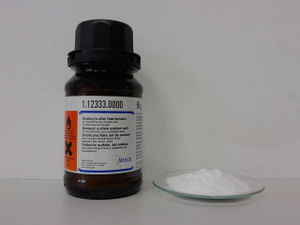Sodium dodecyl sulfate
 Sodium dodecyl sulfate bottle and sample.
| |
| Names | |
|---|---|
| IUPAC name
Sodium dodecyl sulfate
| |
| Other names
Sodium dodecanesulfate
Sodium lauryl sulfate Sodium monododecyl sulfate Sodium monolauryl sulfate | |
| Properties | |
| C12H25SO4Na | |
| Molar mass | 288.372 g/mol |
| Appearance | White solid |
| Odor | Odorless |
| Density | 1.01 g/cm3 |
| Melting point | 206 °C (403 °F; 479 K) |
| Boiling point | Decomposes |
| 0.1 g/100 ml | |
| Solubility | Insoluble in hydrocarbons |
| Vapor pressure | ~0 mmHg |
| Hazards | |
| Safety data sheet | Sigma-Aldrich |
| Lethal dose or concentration (LD, LC): | |
| LD50 (Median dose)
|
1,288 mg/kg (rat, oral) |
| Except where otherwise noted, data are given for materials in their standard state (at 25 °C [77 °F], 100 kPa). | |
| Infobox references | |
Sodium dodecyl sulfate (SDS) or more commonly sodium lauryl sulfate (SLS), is an organic compound with the formula CH3(CH2)11SO4Na. It is widely used as anionic surfactant in many cleaning and hygiene products.
Contents
Properties
Chemical
SLS is the sodium salt of a 12-carbon alcohol that has been esterified to sulfuric acid. An alternative description is that it is an alkyl group with a pendant, terminal sulfate group attached. As a result of its hydrocarbon tail, and its anionic "head group", it has amphiphilic properties that allow it to form micelles, and so act as a detergent.
SLS can be oxidized using oxidizing mixtures like aqua regia to carbon dioxide and water
Physical
Sodium lauryl sulfate is a white solid, slightly soluble in water.
Availability
Pure sodium lauryl sulfate can be bought online or from chemical suppliers.
Preparation
Sodium dodecyl sulfate is synthesized by treating lauryl alcohol (dodecanol) with sulfur trioxide, oleum, or chlorosulfuric acid to produce hydrogen lauryl sulfate, which is neutralized by adding sodium hydroxide or sodium carbonate. Lauryl alcohol can obtained from coconut or palm kernel oil by hydrolysis (which liberates their fatty acids), followed by hydrogenation. If you don't want this route, just use dodecanol.
Projects
- Use as surfactant
- DNA extraction
- Protein denaturation
- Microbicide
Handling
Safety
Sodium dodecyl sulfate has low toxicity and it's considered safe for use. Contact with bare skin will remove the oils from it causing irritation.
Storage
SDS should be kept in closed bottles.
Disposal
No special disposal is required for SDS. It can be safely poured down the drain, though it's recommended to dilute it first.